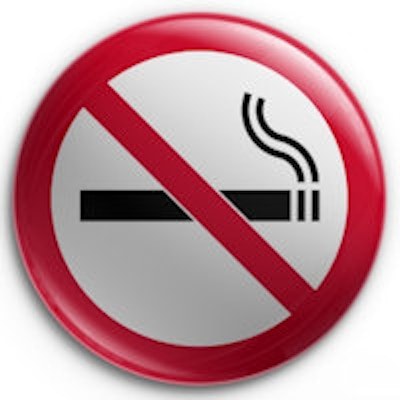
Data from a large study show that CT lung cancer screening may benefit even those with fewer than 30 pack-years of smoking history, according to an October 19 article in the Journal of the National Cancer Institute. The findings could potentially open up screening to millions more smokers, especially women and minorities.
The analysis looked at records of more than 30,000 smokers and former smokers who participated in the Prostate, Lung, Colorectal, and Ovarian Cancer Screening Trial (PLCO) and had smoking histories ranging from 20 to 29 pack-years. Their risk of developing cancer was very similar to that of patients eligible for screening in the National Lung Screening Trial (NLST), which focused on individuals with smoking histories of 30 pack-years or more.
"In terms of lung cancer risk, this group is very similar to a large group that is recommended for screening," said lead author Dr. Paul Pinsky in an interview with AuntMinnie.com.
Pinsky and his colleague Dr. Barnett Kramer are from the U.S. National Cancer Institute (JNCI, October 19, 2015).
Payments focus on 30-plus pack-years
The U.S. Centers for Medicare and Medicaid Services (CMS) early this year finalized reimbursement approval for low-dose CT (LDCT) screening among current and former smokers ages 55 to 80 years with at least 30 pack-years of cigarette smoking history. Smokers with fewer than 30 pack-years weren't included in NLST, so they weren't included in the CMS guidelines.
However, recent research indicates that lung cancer risk can drop dramatically if smokers quit. So, potentially, a former smoker who met the U.S. Preventive Services Task Force (USPSTF) threshold of 30 pack-years might actually have a lower cancer risk than a current smoker with a 20- to 29-pack-year history -- who wouldn't be eligible for screening.
Pinsky and Kramer decided to investigate the impact of smoking history on cancer risk, using data from PLCO. Although PLCO screened patients with chest radiography rather than CT, it did not have a smoking history requirement, so cancer risk could be stratified based on length of smoking history. In particular, the researchers focused on comparing the risk of developing lung cancer for current smokers with 20- to 29-pack-year histories versus current smokers with 30 pack-year histories.
The study cohort included the following:
- 12,243 current smokers with histories of 30 pack-years or more (eligible for screening under USPSTF criteria)
- 2,283 current smokers with histories of 20 to 29.9 pack-years
- 18,114 former smokers with more than 30 pack-years of smoking history who had quit smoking within the past 15 years
After adjusting for age and sex, the researchers estimated hazard ratios for the development of lung cancer for various groups and lengths of smoking history. They used individuals who never smoked as the reference group.
Perhaps as expected, current smokers with histories of more than 30 pack-years had the highest risk of developing cancer. But, surprisingly, current smokers of 20 to 29 pack-years -- who didn't meet USPSTF criteria -- actually had a higher risk of developing cancer than former smokers with more than 30 pack-years who met USPSTF criteria.
| Risk of lung cancer diagnosis based on smoking history | ||||
| Smoking history category | Median pack-years | Meets USPSTF criteria | No. of lung cancers | Hazard ratio |
| Never smoked | 0 | No | 253 | N/A |
| Current smoker (30+ pack-years) | 53 | Yes | 271 | 29.9 |
| Current smoker (20-29 pack-years) | 22.5 | No | 36 | 17.8 |
| Former smoker (30+ pack-years, quit within 15 years) | 51 | Yes | 333 | 16.6 |
Gradual differences by pack-years
"There is no 'cliff' at which risk falls dramatically," Pinsky said. "I think it's a gradual decrease over the pack-years."
The researchers published similar findings last year, when they examined whether there is a drop-off in lung cancer risk based on the number of years since quitting smoking.
"In a very similar way, we were saying there's no 'cliff' after 15 years" since quitting, he said. "It's a gradual thing."
In light of the findings, the potential benefits and harms of recommending CT lung cancer screening should be evaluated in those with 20 to 29 pack-years of smoking history, the Pinsky and Kramer concluded.
Go slow
There are reasons to proceed cautiously in extending screening recommendations, Pinsky told AuntMinnie.com. One caveat is that these 20- to 29-year smokers weren't included in NLST, so there is no "direct evidence" that screening would help them.
Nor is it possible to determine how the attempted addition of new screening subjects would play out in daily clinical practice. But the case for screening remains strong, Pinsky said.
"They have similar exposure to lung cancer risks and are very similar in most other aspects, so it would be very surprising that screening would not work in this group but would work in people who have 30 to 40 and 30 to 50 pack-years," he said.
Finally, it's inappropriate to make major policy decisions based on a single analysis, Pinsky said. But it would be at least as shortsighted to permanently limit lung cancer screening to the precise group that happened to be eligible for NLST.
"I'd say let's start having the conversation of pros and cons, at least in some settings where you can do research on them and learn from it," Pinsky said. "At least consider the possibility of screening in some of these groups, in a setting where you can be cautious about follow-up and limiting the risks."
If screening were expanded to include current smokers with 20- to 29-pack-year histories, it could widen the overall pool of those eligible for screening by 16.3% -- and it would result in substantially larger increases for women and racial minorities, the authors wrote.
Editorial agrees
An accompanying editorial (JNCI, October 19, 2015) by Dr. Francine Jacobson from Brigham and Women's Hospital agreed that it's time to expand the screening roster.
"Drs. Pinsky and Kramer demonstrate sufficient risk of lung cancer in a population with 20 to 29 pack-years to consider screening," she wrote. "More importantly, they have identified lung cancer disease disparity among minority groups that may be rooted in a tendency to develop cancer with less tobacco exposure. This may provide compelling public health evidence to reduce the threshold of screening to 20 pack-years in certain minority groups."




















